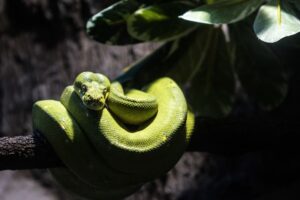Table of Contents
ToggleIntroduction
Tarsiers, unique and captivating primates, are often hailed as nature’s nocturnal marvels. Their distinct characteristics and mesmerizing appearances have intrigued scientists, wildlife enthusiasts, and curious minds for centuries. Let’s explore the fascinating world of these diminutive creatures as we set out to learn their secrets.
Brief Overview Of Tarsiers As Primates
Tarsiers belong to the order Primates, which encompasses various animals ranging from lemurs to humans. Despite their small size, tarsiers share several features with their primate relatives, such as forward-facing eyes, grasping hands and feet, and a relatively large brain. However, their uniqueness sets them apart, as they possess a combination of traits that make them stand out in the primate world.
Physical Characteristics
Small Size and Lightweight Body
Tarsiers are characterized by their diminutive size, making them some of the smallest primates in the world. Their body length typically ranges from 10 to 16 centimeters, with their long bushy tail adding 20 to 25 centimeters. Despite their small stature, tarsiers exhibit a remarkable lightweight build, enabling them to navigate the treetops swiftly and precisely.
Large Eyes and Adaptations for Nocturnal Life
The most iconic feature of tarsiers is their disproportionately large eyes. These eyes are highly adapted for low-light conditions and lack a tapetum lucidum—a reflective layer in many nocturnal animals’ eyes. This unique absence prevents the eerie “eye-shine” commonly seen in other nocturnal creatures. The tarsier’s eyes are fixed in their sockets, requiring the animal to rotate its head for a wider field of vision.
Specialized Fingers and Toes (Tarsal Bones)
The elongated appearance of the tarsal bones in a tarsier gives the impression that the animal has lengthy fingers and toes. These specialized tarsal bones aid tarsiers in maintaining a firm grip on branches and tree trunks, allowing them to move with incredible ease and speed through the trees. This adaptation is essential for their arboreal lifestyle, as they rely on swift movements to capture prey and escape predators.
Ears and Acute Hearing Capabilities
In addition to their remarkable eyes, tarsiers possess susceptible ears, contributing to their exceptional nocturnal hunting skills. Their large ears can capture a wide range of auditory frequencies, helping them locate insects and small prey with pinpoint accuracy. This acute hearing allows tarsiers to thrive in densely vegetated habitats, where visibility may be limited, but the forest sounds are abundant.
Habitat And Distribution
Tropical Rainforests and Secondary Forests
Tarsiers find their home within Southeast Asia’s lush embrace of tropical rainforests and secondary forests. These habitats provide the ideal conditions for their specialized nocturnal lifestyle.
The dense vegetation, diverse plant species, and abundant insect populations create a rich and complex environment that supports tarsiers’ unique adaptations and behaviors.
Geographical Range
Tarsiers’ distribution spans several countries in Southeast Asia, including the Philippines, Borneo, and Sumatra. Within these regions, they inhabit specific pockets of suitable habitats, often favoring areas with abundant tree cover and a variety of vegetation. Each geographical region houses different species of tarsiers with distinct characteristics and ecological niches.
Specific Habitats Within Forests (Tree-Dwelling)
Tarsiers are creatures of the trees, rarely venturing to the forest floor. Their exceptional adaptations for tree-dwelling enable them to cling to branches, move swiftly between trees, and capture prey in the high canopy. This arboreal lifestyle provides ample food sources and protects them from ground-dwelling predators.
Behavior And Lifestyle
Nocturnal and Arboreal Behavior
Tarsiers are true masters of the night, exhibiting a distinct nocturnal behavior that shapes their entire lifestyle. Their large eyes, specialized for low-light conditions, allow them to see clearly in the dark, enabling them to hunt for prey and move through the trees under cover of darkness. During the day, tarsiers often rest in tree hollows or other hidden spots, conserving energy for their nightly activities.
Predatory Nature and Diet
Tarsiers are skilled hunters, relying primarily on insects and small vertebrates for sustenance. Their exceptional agility and keen senses allow them to locate prey with precision. With their acute hearing and excellent night vision, tarsiers pounce on unsuspecting insects and small animals, showcasing their prowess as apex predators within their forest habitat.
Communication Methods
Tarsiers communicate with each other using a combination of vocalizations and scent marking. Their vocal repertoire includes a range of calls, from soft chirps to high-pitched squeals. These vocalizations serve various purposes, such as establishing territory, attracting mates, and warning of potential threats. Additionally, tarsiers mark their territories with scent secretions from specialized glands, ensuring clear boundaries within their home ranges.
Solitary or Small Family Groups
In the wild, tarsiers are solitary or part of small groups of a mating pair and their young. Their reclusive nature helps reduce competition for resources within their densely populated habitat. To attract potential partners during mating season, males may compete with one another vocally.
Reproduction And Life Cycle
Mating Behavior and Seasonality
Their solitary or small group lifestyle influences tarsiers’ mating behavior. To woo potential mates during mating season, men sometimes make loud noises. These vocalizations serve as a way to establish dominance and signal reproductive fitness. Mating typically occurs within the female’s territory, and after successful courtship, the female may temporarily allow the male to share her space.
Gestation Period and Birth of Offspring
After successful mating, tarsier females undergo a gestation period of around 180 days, which is notably long for size. This extended period ensures that the developing offspring have the best chance of survival upon birth. The female tarsier usually only has one baby at a time, and her newborn will already have its eyes open and fur covering its body when it is born.
Parental Care and Nurturing of Young
Tarsier mothers exhibit dedicated parental care, nursing, and protecting their young with vigilance. The infants cling to their mother’s belly or back, relying on her for nourishment and warmth. As the young tarsier grows, the mother introduces them to solid food, playing a vital role in their development and survival during the critical early stages of life.
Development and Growth Stages
The infancy of a tarsier is marked by rapid growth and development. The young tarsier gains strength and coordination by clinging to its mother’s fur as she moves through the trees. As they grow older, they become more independent, learning essential hunting and movement skills. Over time, the young tarsier becomes increasingly self-sufficient, eventually setting out to establish its territory and reproduce.
Conclusion
In the depths of Southeast Asian rainforests, the tarsiers reveal themselves as nature’s enigmatic treasures. Our exploration into their world has unveiled a tapestry of unique characteristics, behaviors, and significance that paints a vivid picture of their existence.
From their oversized eyes designed for moonlit pursuits to their elongated fingers and toes facilitating agile tree-bound navigation, tarsiers exemplify the exquisite balance between form and function in the natural world. As nocturnal hunters and arboreal denizens, they embody a delicate harmony within their ecosystems.







